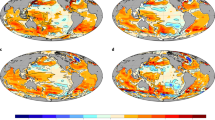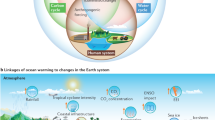Abstract
Through its ability to transport large amounts of heat, fresh water and nutrients, the ocean is an essential regulator of climate1,2. The pathways and mechanisms of this transport and its stability are critical issues in understanding the present state of climate and the possibilities of future changes. Recently, global high-quality hydrographic data have been gathered in the World Ocean Circulation Experiment (WOCE), to obtain an accurate picture of the present circulation. Here we combine the new data from high-resolution trans-oceanic sections and current meters with climatological wind fields, biogeochemical balances and improved a priori error estimates in an inverse model, to improve estimates of the global circulation and heat fluxes. Our solution resolves globally vertical mixing across surfaces of equal density, with coefficients in the range (3–12) × 10-4 m2 s-1. Net deep-water production rates amount to (15 ± 12) × 106 m3 s-1 in the North Atlantic Ocean and (21 ± 6) × 106 m3 s-1 in the Southern Ocean. Our estimates provide a new reference state for future climate studies with rigorous estimates of the uncertainties.
This is a preview of subscription content, access via your institution
Access options
Subscribe to this journal
Receive 51 print issues and online access
$199.00 per year
only $3.90 per issue
Buy this article
- Purchase on Springer Link
- Instant access to full article PDF
Prices may be subject to local taxes which are calculated during checkout



Similar content being viewed by others
References
Macdonald, A. M. & Wunsch, C. An estimate of global ocean circulation and heat fluxes. Nature 382 , 436–439 (1996).
Houghton, J. T. et al. (eds) Climate Change 1995 (Cambridge Univ. Press, 1996).
Ganachaud, A. Large Scale Oceanic Circulation and Fluxes of Freshwater Heat, Nutrients and Oxygen. Thesis, Massachusetts Institute of Technology, Woods Hole Oceanographic Institution, (1999).
Ganachaud, A., Wunsch, C., Marotzke, J. & Toole, J. The meridional overturning and large-scale circulation of the Indian Ocean. J. Geophys. Res. (in the press).
Roemmich, D. & McCallister, T. Large scale circulation of the North Pacific Ocean. Prog. Oceanogr. 22, 171–204 (1989).
Broecker, W. S., Sutherland, S. & Peng, T.-H. A possible 20th-century slowdown of Southern Ocean deep water formation. Science 286, 1132– 1135 (1999).
Orsi, A. H., Johnson, G. C. & Bullister, J. L. Circulation, mixing and production of Antarctic Bottom Water. Prog. Oceanogr. 43, 55– 109 (1999).
Gordon, A. L., Susanto, R. D. & Ffield, A. Throughflow within the Makassar Strait. Geophys. Res. Lett. 26, 3325–3328 (1999).
Jackett, D. R. & McDougall, T. J. A neutral density variable for the world's oceans. J. Phys. Oceanogr. 27, 237–263 (1997).
Munk, W. & Wunsch, C. The Moon and mixing: abyssal recipes II. Deep-Sea Res. I 45, 1977– 2010 (1998).
Polzin, K. L., Toole, J. M., Ledwell, G. R. & Schmitt, R. W. Spatial variability of turbulent mixing in the abyssal ocean. Science 276, 93–96 ( 1997).
Toggweiler, J. R. & Samuels, B. On the ocean's large-scale circulation near the limit of no vertical mixing. J. Phys. Oceanogr. 28, 1832–1852 (1998).
da Silva, A., Young, C. & Levitus, S. Atlas of Surface Marine Data Vol. 1, Algorithms and Procedures (NOAA Atlas NESDIS 6, US Dept of Commerce, 1994).
Garnier, E., Barnier, B., Siefridt, L. & Béranger, K. Investigating the 15-year air-sea flux climatology from the ECMWF reanalysis project as a surface boundary condition for ocean models. Int. J. Climatol. (in the press).
Manabe, S. & Stouffer, R. J. Two stable equilibria of a coupled ocean-atmosphere model. J. Clim. 1, 841– 866 (1988).
Marotzke, J. in Decadal Climate Variability, Dynamics and Predictability (eds Anderson, D. L. T. & Willebrand, J.) Vol. I, 44 (NATO ASI/Springer, 1996).
Gleckler, P. J. & Weare, B. C. Uncertainties in global ocean surface heat flux climatologies derived from ship observations. J. Clim. 10, 2764–2781 (1997).
Josey, S. A., Kent, E. C. & Taylor, P. K. New insights into the ocean heat budget closure problem from analysis of the SOC air-sea flux climatology. J. Clim. 9, 2856–2880 (1999).
Keith, D. W. Meridional energy transport: uncertainty in zonal means. Tellus 47, 30–44 ( 1995).
Ganachaud, A. & Wunsch, C. Oceanic nutrient and oxygen fluxes during the World Ocean Circulation Experiment and bounds on export production. Glob. Biogeochem. Cycles (submitted).
Macdonald, A. The global ocean circulation: a hydrographic estimate and regional analysis. Prog. Oceanogr. 41, 281– 382 (1998).
Schmitz, W. J. Jr & McCartney, M. S. On the North Atlantic circulation. Rev. Geophys. 31 , 29–49 (1993).
Wunsch, C. The Ocean Circulation Inverse Problem 437 (Cambridge Univ. Press, 1996).
Anderson, L. A. & Sarmiento, J. L. Redfield ratios of remineralization determined by nutrient data analysis. Glob. Biogeochem. Cycles 8, 65–85 (1994).
Broecker, W. S. “NO”, a conservative water-mass tracer. Earth Planet. Sci. Lett. 23, 100–107 ( 1974).
McDougall, T. Neutral surfaces. J. Phys. Oceanogr. 17, 1950–1964 (1987).
McDougall, T. J. in Parameterization of Small-Scale Processes, Hawaiian Winter Workshop Aha Hulikoa 355–386 (Univ. Hawaii, Manoa, 1991).
Stammer, D., Tokmakian, R., Semtner, A. & Wunsch, C. How well does a 1/4° global circulation model simulate large scale oceanic observations? J. Geophys. Res. 101, 25779 –25811 (1996).
Trenberth, K. E. & Solomon, A. The global heat balance; heat transports in the atmosphere and ocean. Clim. Dyn. 10, 107–134 ( 1994).
de las Heras, M. & Schlitzer, R. On the importance of intermediate water flows for the global ocean overturning. J. Geophys. Res. 104, 15515–15536 (1999).
Bryden, H. L., Roemmich, D. H. & Church, J. A. Ocean heat transport across 24° N in the Pacific. Deep-Sea Res. 38, 297– 324 (1991).
Acknowledgements
This work was completed while A.G. was a graduate student in the MIT/WHOI Joint Program in Physical Oceanography. We thank J. Toole, B. Warren, J. Marotzke, D. Glover and N. Hogg. B. Arbic, G. McKinley, A. Czaja, A. Macdonald, J. Marshall and M. Fieux also provided helpful comments on the manuscript. We are grateful to the principal investigators who provided the data from the World Ocean Circulation Experiment and the Franco-Indonesian Java-Australia Dynamic Experiment. G. Brown and D. Spiegel helped to design the figures. We were supported by the Jet Propulsion Laboratory and by gifts from Ford, General Motors and Daimler-Chrysler to MIT's Climate Modelling Initiative. This work is a contribution to the World Ocean Circulation Experiment.
Author information
Authors and Affiliations
Corresponding author
Additional information
MIT 54-1517, 77 Massachusetts Avenue, Cambridge, Massachusetts 02139, USA
Rights and permissions
About this article
Cite this article
Ganachaud, A., Wunsch, C. Improved estimates of global ocean circulation, heat transport and mixing from hydrographic data. Nature 408, 453–457 (2000). https://doi.org/10.1038/35044048
Received:
Accepted:
Issue Date:
DOI: https://doi.org/10.1038/35044048
This article is cited by
-
Oxygen isotope constraints on the ventilation of the modern and glacial Pacific
Climate Dynamics (2024)
-
Energetic overturning flows, dynamic interocean exchanges, and ocean warming observed in the South Atlantic
Communications Earth & Environment (2023)
-
Internal multi-centennial variability of the Atlantic Meridional Overturning Circulation simulated by EC-Earth3
Climate Dynamics (2023)
-
The dependence of upper ocean gyres on wind and buoyancy forcing
Geoscience Letters (2022)
-
Frequency of the winter temperature extremes over Siberia dominated by the Atlantic Meridional Overturning Circulation
npj Climate and Atmospheric Science (2022)
Comments
By submitting a comment you agree to abide by our Terms and Community Guidelines. If you find something abusive or that does not comply with our terms or guidelines please flag it as inappropriate.



